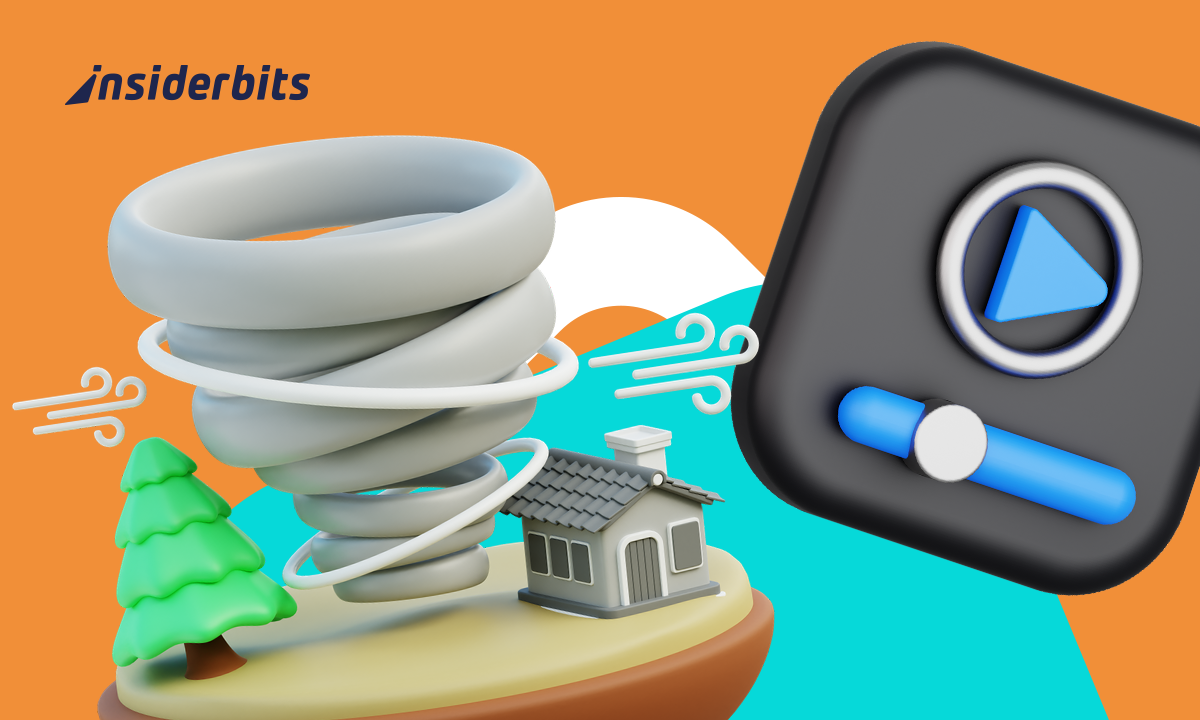Tornado chasers are going live, and audiences can’t get enough. Storm streamers are turning chaotic skies into viral broadcasts with heart-pounding moments and real-time weather alerts.
These creators mix science, suspense, and raw visuals as they track deadly storms across the country. Some stream from rooftops, others from inside the eye of the storm.
In this thrilling guide by Insiderbits, we’ll reveal the tech, the risk, and the growing debate behind it all. Make sure to stick around, things are just getting intense.
Correlato: Hurricane Alert Apps: Stay Safe During Storm Season
Why storm streamers are breaking the internet
What began as storm chasing for science has evolved into gripping livestreams watched by thousands. These broadcasts mix danger, timing, and human instinct to create real-time drama.
Viewers tune in not just for weather, but for emotion, chaos, and connection. The viral success of storm streamers shows how raw weather coverage meets a growing digital audience.
Why live tornado coverage is exploding online
Tornado footage used to come after the damage. Now, it happens live. Streamers race alongside the storm, and viewers get to witness nature’s extremes as they unfold.
Livestreams offer authenticity in a media world often curated and delayed. Each second brings risk, updates, and unpredictable turns, making every broadcast feel urgent and real.
Streamers narrate their fears, missteps, and triumphs, turning extreme weather into stories with stakes, suspense, and raw emotion, weather becomes something people watch and discuss.
What makes storm chasing so addictive to viewers
Storm streamers pull viewers into the heart of danger. Their feeds turn distant tornadoes into gripping moments, blending raw adrenaline with real-time decisions and human perspective.
There’s no script and no guarantee of safety. Just a person, a lens, and storms that shift without warning. That unpredictability makes the experience impossible to ignore.
Tornado sirens wail, hail hammers glass, and every choice unfolds live. Storm streams feel chaotic, but strangely personal, as viewers witness survival play out frame by frame.
Streamers turning chaos into viral content
With thousands tuning in each storm season, storm streamers have turned unpredictable weather into viral broadcasts that inform, and sometimes even help save lives in real time.
- Convective Chronicles: focuses on radar visuals and analytical breakdowns, ideal for viewers who value meteorological depth and reliable interpretation of unfolding threats;
- Ryan Hall, Y’all: offers energetic, educational coverage with strong viewer engagement and life-saving updates during severe weather events across the U.S.;
- Max Velocity: prioritizes accuracy and calm narration, helping audiences understand threat levels and timing without sensationalism during live tornado tracking;
- Connor Croff: delivers raw footage and on-the-road tension, making his streams feel like a front-row seat to unpredictable storm behavior;
- Pecos Hank: combines cinematic storm visuals with eerie calm, offering a more artistic and emotional portrayal of nature’s most violent moments.
Where storm chasers stream live
Many storm streamers rely on platforms like YouTube e Twitch to broadcast live. These spaces support high-quality video, live chat, and alerts that keep audiences engaged.
Facebook Live e X also play a role, especially for mobile chasers. Fast uploads, instant reactions, and wide sharing make them ideal for updates when every second counts.
Some use dedicated weather platforms or custom apps to host streams. These options cater to storm enthusiasts looking for deeper analysis, radar integration, and archived footage.
How streams build weather awareness
By showing conditions firsthand, storm streamers help viewers recognize real tornado risks. Watching debris clouds form or skies shift builds a visual memory of what danger looks like.
Live commentary adds value. Chasers explain radar images, weather terms, and safety zones as they drive, turning intense moments into powerful learning opportunities for anyone tuning in.
These streams also highlight just how quickly weather can change. Seeing forecasts fail or paths shift reminds viewers to stay alert and never underestimate the power of a storm.
Tech behind live tornado tracking
Modern tornado coverage feels like a live documentary. What viewers don’t see is the level of precision, prep, and power packed into each vehicle before storms even form.
Between camera rigs, radar feeds, and mobile hotspots, every second relies on gear working perfectly under pressure. All of it is handled in motion by storm streamers chasing violent skies.
The gear turning storm chasers into broadcasters
Streaming a tornado isn’t just pointing a phone at the sky. Many chasers use full dashboard setups with mounts, tripods, and routers running from portable batteries.
Professional-grade cameras capture clean, stable shots even while bouncing down rural backroads. Paired with powerful lenses, they bring distant funnel clouds right up close.
Add-ons like external microphones and signal boosters improve quality while increasing safety. Clear audio and stable video make the difference between a blurry moment and viral coverage.
Radar apps, GPS, and 360° cameras in action
Storm streamers rely on radar visuals and apps to monitor rotation, wind shifts, and movement patterns. These tools guide their chase decisions and keep them one step ahead of danger.
GPS systems help avoid blocked roads, debris fields, and zones already impacted. Real-time positioning is key when every second counts and visibility drops without warning.
360° cameras capture the storm’s impact. Viewers see lightning, funnel clouds, and reactions in real time, creating a complete experience without missing what’s happening inside the vehicle.
Drones above, dashcams below: capturing every angle
Some of the most dramatic footage comes from storm streamers who use drones to fly above chaos, giving views that ground cameras simply can’t reach or survive.
While drones capture wide aerial views, dashcams record up-close ground action, blowing debris, intense wind, and howling sirens. Together, they create a complete storm narrative.
This layered approach to filming has helped storm streamers build loyal followings. People want different perspectives, and the combination of gear delivers them without filters or delay.
Correlato: Disaster Relief Coordination Apps: Supporting Communities in Crisis
How streamers stay safe on camera
Chasing tornadoes isn’t just about capturing stunning footage. Staying safe requires sharp instincts, planning, and constant awareness of shifting weather and unpredictable conditions.
Streamers manage multiple screens, radios, and gear while navigating dangerous routes in real time. Their ability to think clearly under pressure is what keeps disaster at bay.
Despite the chaos outside, seasoned chasers follow routines that minimize risk. These safety habits often go unnoticed, but are essential to the survival of most storm streamers in the field.
Route planning, storm modeling, and emergency protocols
Before the cameras roll, streamers spend hours reviewing models, forecasts, and potential escape routes. Knowing where a storm might go is key to staying ahead of it.
They rely on multiple radar apps and forecasting tools to make decisions fast. Backup plans, rural exits, and local shelter maps are loaded before they even hit the road.
What happens when things go off-script
Sometimes, no amount of planning can prevent trouble. Cell towers go down, roads flood, and storms change course, forcing streamers to react with speed and caution.
Vehicles can get stuck or damaged. Cameras fall. Fear spikes. In those moments, instincts take over, and streamers shift focus from filming to making it out alive.
Safety tips inspired by seasoned storm chasers
Behind every viral moment is a list of hard-earned safety habits. Storm streamers rely on routines that help them balance risk and readiness in extreme conditions.
- Always have multiple escape routes: roads can vanish or get blocked. Alternate paths give streamers options when things change quickly;
- Never chase at night: darkness hides rotation and debris. Most streamers avoid night storms to maintain visibility and avoid deadly surprises;
- Don’t rely on one signal source: losing connection mid-storm is common. Redundancy helps streamers stay informed when cell towers drop out;
- Monitor more than just radar: wind speed, humidity, and atmospheric pressure matter too. Many streamers use multiple metrics to understand storm strength;
- Pull back when uncertain: if the storm behavior feels off, they retreat. Safety is always more important than capturing that final shot.
Ethics of streaming natural disasters
Live tornado coverage can save lives, but it also risks turning tragedy into entertainment. The fine line between public service and spectacle can really blur during chaotic storm moments.
As views and donations increase, some storm streamers face criticism for dramatizing danger. Others gain respect for clear, responsible reporting. This raises complex questions.
When does real-time coverage cross the line?
Viewers want authenticity, but danger draws clicks. When a chaser zooms into destruction or ignores warnings, the coverage can feel more reckless than responsible.
Streaming becomes ethically questionable when it glamorizes risk or overlooks suffering. Documenting storms is valuable, until the focus shifts from awareness to adrenaline.
Informing or sensationalizing: where the public stands
Audiences are split. Some see storm coverage as heroic and informative. Others criticize it for exploiting fear, especially when victims appear on camera without consent.
Comments and donations reflect this divide. While many thank streamers for updates, others accuse them of chasing trauma. These opposing views continue to fuel heated online debate.
Should platforms set boundaries for high-risk content?
While policies exist for violence and misinformation, storm streamers operate in a gray zone where danger is real, but intent varies with each broadcast and creator.
Platforms often promote trending streams regardless of risk. That raises questions about their role in encouraging or discouraging extreme content during life-threatening events.
Correlato: Emergency Preparedness Apps: Staying Safe in Uncertain Times
When weather meets the web, stories go viral
Storm chasing online has changed how people view severe weather. What once felt distant is now streamed live, creating connection, awareness, and admiration for those behind the lens.
This guide was crafted by Insiderbits to unpack the rush, risk, and reach of storm streamers, those capturing danger in real time while the internet holds its breath.
Liked this article? There are plenty of others like this here at Insiderbits. Stick around and find fresh content made to inform, surprise, and keep your curiosity moving forward.





